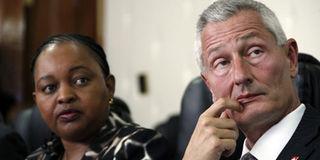Women now head a third of Kenyan households

Devolution and Planning Cabinet Secretary Ann Waiguru (left) and Swiss Ambassador to Kenya Jacques Pitteloud during the launch of the Socio-Economic Atlas of Kenya at Harambee House in Nairobi on November 10, 2014. PHOTO | EVANS HABIL | NATION MEDIA GROUP
What you need to know:
- The survey shows that female-headed households stand at below the national average in urban areas but rises above 33 per cent in rural areas, mainly driven by the migration of able-bodied men to towns.
Up to one third of Kenya’s 8.5 million households are headed by women, a newly released national population map shows, pointing to the big cultural shift that is sweeping across the country.
The Kenya Socio-Economic Atlas that was officially released Monday shows that Samburu tops the list of counties with the highest number of female-run families.
Up to 45 per cent of the households (22,500) in the county, which is located in the semi-arid northern Kenya region, or nearly one in every two, are headed by a woman.
The combination of adverse weather and man-made conditions such as inter-ethnic wars are known to cause high levels of attrition of men in the area, leaving women to fend for families.
CULTURAL PRACTICES
Ironically, Mandera — in northern Kenya and in an equally dry environment and with equally deadly inter-ethnic wars — is the county with the least number of women-headed households.
Cultural practices and religious beliefs that ensure remarriage of widows are thought to be the glue that has kept the traditional family fabric intact, leaving only 18.7 per cent of households (of the total 23,400 units) headed by women.
The survey shows that female-headed households stand at below the national average in urban areas but rise above 33 per cent in rural areas, mainly driven by the migration of able-bodied men to towns.
The study found that the number of female-headed homes has been rising steadily in some towns due to availability of employment opportunities that have enabled many educated women to sustain themselves.
SUPPORT DECISION MAKING
Planning Secretary Anne Waiguru said the government had released the information to support decision making by the private sector and in the counties.
“The government always held this detailed information for planning purposes, but we are releasing it to the public for the first time to ease decision making by (the) private sector and the counties,” she said, adding that the map is a user-friendly version of the Economic Survey that captures every little detail down to a sub-location level.
“We expect it to trigger a debate about the development levels across the counties,” she said.
And in a finding that points to the size of Kenyan families, the socio-economic map shows that 19.2 per cent of Kenyan households (1.7 million families) have more than seven members.
LARGEST FAMILIES
Mandera, with 77.3 per cent of its households having more than seven members, tops the list of counties with the largest families, followed by Wajir (64.7 per cent) and Turkana (54.7 per cent).
Kirinyaga, with only 5.2 per cent of households having more than seven members, has the smallest families, followed by Nairobi (6.1 per cent) and Nyeri (6.3 per cent).
Nairobi tops the list of counties with small households. The map shows that 63 per cent of the city's families have between one and three members, followed by Mombasa’s 160,200 households of similar sizes (or 59.6 per cent).
But in a finding that is likely to ignite fresh national debate on the formula that the Commission of Revenue Allocation (CRA) has been using to assign more funds to counties such as Nairobi, the socio-economic indicators show that distribution of resources has been skewed in favour of urban areas.
NAIROBI'S ADVANTAGES
Nairobi’s 814,200 households enjoy the best roads and have many schools, with 88.3 per cent of them owning mobile telephone handsets and 22.3 per cent enjoying robust Internet connectivity.
Similarly, nearly four in five households in Nairobi own radios and TV sets, 82.7 per cent have access to safe drinking water and 72.4 per cent use electricity for lighting.
By comparison, only 15.9 per cent of households in Turkana own mobile phones, 1.3 per cent of Mandera residents use the Internet, 94 per cent of households in Homa Bay use paraffin for lighting, while only 21.4 per cent of Narok residents have access to safe drinking water.
The Constitution guarantees the 47 counties at least 15 per cent of the national revenue to be distributed according to a formula devised by CRA.
This article was first published in the Business Daily




